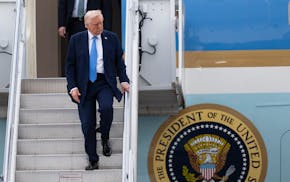Faced with the two biggest crises of his political career, Gov. Tim Walz responded in starkly different ways.
As a daunting and previously unknown virus swept the globe, the DFL governor took aggressive measures to protect people from COVID-19, shuttering businesses and schools and ordering Minnesotans to stay home.
When riots engulfed Minneapolis after the killing of George Floyd, Walz was more cautious. Minneapolis Mayor Jacob Frey requested National Guard assistance on the evening of May 27, 2020. Walz didn't activate the Guard until the next afternoon, and troops didn't arrive at the area where rioters torched the city's Third Precinct police headquarters until after it had burned.
Walz's management of those two unprecedented emergencies, as well as other natural disasters, offers insight into how he might respond to a national crisis as vice president. The Minnesotan could be in the White House if he and Democratic presidential nominee Kamala Harris are elected in November.
"I've watched Tim Walz just lead Minnesota through some of the most challenging chapters in our nation's history," Lt. Gov. Peggy Flanagan said in an interview. "I think a value that he holds, and that we hold in our office, is that we do the right thing, even when it's hard."
Flanagan said Walz's top priority in a crisis is the safety of Minnesotans. She said he consults teams of advisers before making decisions: "I watched him make the best decisions that he could with the information that was available."
Paul Gazelka, the Republican majority leader of the Minnesota Senate during the riots, said his top concern about Walz becoming vice president is that "in a crisis, he responds poorly." Gazelka, who phoned the Trump White House during the riots to request assistance, said Walz should have activated the Guard sooner.
"I think [Walz] was weighing political ramifications of being too tough," Gazelka said. "This was a crisis that he failed in. Now you're vice president and you're in the situation room and it's China or Russia? You don't get do-overs."
Teddy Tschann, a spokesman for the Harris-Walz campaign, said in a statement that Walz is a "trusted, tested leader. As a former member of the Minnesota National Guard, member of Congress, and as Governor, Tim Walz has always stood up for Minnesotans and taken action to keep his neighbors safe."
Pandemic response
Walz was front and center throughout the pandemic. Early on, he held daily briefings from the governor's residence on video to explain the rationale behind his decisions. He issued a stay-at-home order and other restrictions to give hospitals time to build capacity and curb the spread of the virus until vaccines were available.
Amid a global testing shortage, Walz harnessed the capacity of the University of Minnesota and Mayo Clinic, reaching a deal with them for up to 20,000 COVID-19 tests per day. He helped bring in a deployment of military doctors and nurses when hospitals were overwhelmed.
As vaccinations were rolled out, Walz sat side-by-side with former Republican Gov. Tim Pawlenty as the two received their first dose.
Through it all, Walz remained conscious of "balancing the effects on health, the effects on the economy and the effects on society," said former state Health Commissioner Jan Malcolm. Walz would listen to his economic development commissioner about the consequences of business restrictions, and then he would listen to Malcolm about the risk of reopening too early. The debates were vigorous, Malcolm said.
"There certainly was no knee-jerk decisionmaking by him or any of us," Malcolm said.
Republicans were critical of how long Walz exercised emergency executive powers, trying several times to undo them. They also disagreed with the school and business closures.
Gazelka said he thinks the state enforced pandemic restrictions inconsistently. Walz placed restrictions on funeral services and religious gatherings, Gazelka said, but allowed restrictions to be violated for the funeral of Floyd.
"Where was the science?" Gazelka said.
State Sen. Karin Housley, R-Stillwater, criticized Walz for allowing COVID-19 patients to be transferred from hospitals back into nursing homes, where they could endanger elderly residents. In the first few months of the pandemic, about 80% of the Minnesotans who died of COVID-19 were residents of nursing homes and assisted-living facilities.
"He failed to protect those most vulnerable," Housley said.
Malcolm said there were no recorded incidents of transferred patients infecting residents, as they were kept in separate areas. She said transmission occurred more frequently from workers moving between facilities.
The riots
After Floyd was killed by Minneapolis police, thousands took to the streets in protest. Walz was initially sympathetic toward the protests, saying it's "how people express their pain, process tragedy and work to create change."
Flanagan said Walz responded to the moment with empathy for the grief that spilled onto streets in cities nationwide.
"Our hearts were ripped wide open in Minnesota," Flanagan said. "I have watched the governor meet people whose hearts are breaking and going through deep, deep trauma."
Then the riots started. Several buildings were set on fire that Wednesday night, two days after Floyd was killed, prompting Mayor Frey and Minneapolis Police Chief Medaria Arradondo to both request National Guard assistance. Frey said at the time that Walz "did not say yes. He said he would consider it."
Walz weighed whether deploying soldiers to police brutality protests would worsen the situation. He didn't activate the Guard until Thursday afternoon.
Asked why Walz didn't activate the Guard sooner, Flanagan didn't directly answer, instead saying, "the only person on the presidential ticket that was involved in a riot was Donald Trump on Jan. 6."
The morning after the precinct was set ablaze, Walz had a private phone call with the mayors and police chiefs of Minneapolis and St. Paul. Walz gave no indication during the call that he was about to publicly blast Minneapolis' response to the riots as an "abject failure," Frey has previously said.
Frey and his staff were blindsided when Walz delivered that blistering critique at a news conference hours later: "Feels like Mpls is getting thrown under the bus," Frey's chief of staff, Gia Vitali, texted to Walz's chief of staff and deputy chief of staff.
The mayor and his staff arranged interviews with local media for Frey to respond to the governor but called them off at the last minute, opting against a public spat during a crisis.
Widespread arson, looting and violence continued that Friday. Several thousand National Guard soldiers deployed across the Twin Cities on Saturday and restored order.
Former President Donald Trump privately praised Walz after the riots ended, saying he "dominated" the situation. Trump labeled Frey a "very weak Radical Left Mayor" in a tweet during the riots.
Now that Walz is on the presidential ticket, Trump and other Republicans are recasting the riots in a different light that's more critical of the governor than of Frey.
"Governor Walz allowed Minneapolis to burn for days, despite President Trump's offer to deploy soldiers and cries for help from the liberal Mayor of Minneapolis," a Trump campaign spokesperson said in a recent statement to the Associated Press.
In an interview Wednesday, Frey maintained that the city did "everything that we could to quell one of the most difficult situations that we've ever had in Minneapolis." He reiterated that he asked for the National Guard "immediately."
"The experiences that I had in 2020, and perhaps more importantly the preparatory work we've done since then, have made me a better mayor," said Frey, who's supporting the Harris-Walz campaign. "While I don't speak for the governor, I'm certain that he's in the same boat."
Natural disasters
Walz has acted quickly in response to natural disasters, authorizing emergency assistance for areas affected by flooding and tornadoes. He visits places where disasters have struck to survey damage firsthand.
In April 2022, an EF-2 tornado ripped through the small town of Taopi near the Iowa border, destroying 10 of its 24 homes.
"When we got up in the morning, it was like a war zone," Taopi Mayor Mary Huntley said.
Walz visited Taopi two days after the tornado hit, vowing to assist the community as it rebuilds: "We don't move on until it's done."
Huntley said Walz met with her and her 94-year-old mother, whose home was destroyed.
"You'd think he was talking to his own mother," Huntley said of Walz. "He immediately forms relationships with people and finds that ground to make them feel good."
Staff writer Jeremy Olson contributed to this report.

U.S. Bancorp executive believed to be aboard plane that crashed into Brooklyn Park home

Trump says he's considering ways to serve a third term as president

Trump's promised 'Liberation Day' of tariffs is coming. Here's what it could mean for you

Trump roars down multiple paths of retribution as he vowed. Some targets yield while others fight

